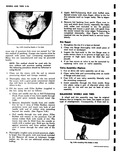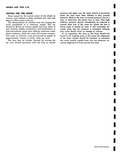Jeep Parts Wiki | Ford Parts Wiki
Home | Search | Browse
Prev

 Next
Next
ta v Fig 3 51 Stitching Patch 1 sta ility develops the tire and wheel assembly should be checked for static and in severe cases dynamic ba ance The assembly should also be checked for ba ance whenever any original tire is removed or re aired and especially in cases where nonstandard ti equipment such as an extra ply casing is used Bs ancing is important on service replacements of r wl eels tires drums or any combination of the three be ause all assemblies are balanced at the factory to a tal maximum unbalance of 11 inch ounces 6 inch ou ices on the hub and drum assembly and 5 inch ov ices on wheel and tire assembly NOTE Before attempting to balance the wheels check to be certain that no foreign matter has been trapped in the wheel venti lation slots This is especially critical if the vehicle has been run in soft mud and then parked in freezing weather itatic Balance still balance is the equal distributi a of weight of the wheel and tire assembly about th axis of rotation so that the assembly has no tender y to rotate by itself Static unbalance causes the p xnding action of the front wheels that is called 1 amp fo correct static unbalance Remove wheel and hub from spindle as a unit Clean all grease from wheel bearings and races Clamp a clean spindle in a bench vise or if the spindle on the car must be used clean it carefully Mount the wheel on the spindle and adjust the bearings loosely so that the wheel is just held in position and is practically frictionless Make sure that the tire is inflated to the correct pressure Start the wheel in motion and allow it to stop by itself When it stops the heavy side will be a1 the bottom Mark the heaviest point and also the uppermost or lightest point 8 Install two balancing weights on the rim opposite each other and 180 away from the heavy point 9 Move these weights equally in opposite direction toward the heavy side until the wheel is in balance 10 Repack wheel bearings reinstall and adjust bearings as explained in this section under Front Wheel Bearings Adjust Dynamic Balance running balance requires not only that the wheel be in static balance but also that it runs smoothly at all speeds on an axis which runs through the center line of the wheel and tire and is perpendicular to the axis of rotation Dynamic unbalance sets up forces which cause the wheels to wobble or shimmy The quickest and best methods of testing and correcting dynamic unbalance are by the use of dynamic wheel balancers which are available commercially These commercial balancers include all necessary instructions on where and how the balancing weights should be placed The following information however will help in the correction of dynamic balance When a wheel that is statically unbalanced is dynamically in balance the dynamic balance can be retained while correcting the static balance by installing the corrective weights so that half of the weight required is placed on the inner edge of the rim and the other half on the outer edge of the rim Dynamic unbalance can be corrected without destroying static balance by installing weights so half of weight required for dynamic balance is placed on the rim opposite the heavy point while the other half is placed 180 away and on the opposite side of the rim WHEEL RUN OUT AND ECCENTRICITY The wheels should not run out wobble more than 1 as measured on the side of the rim at the base of the tire Excessive run out is the result of a bent wheel an improperly mounted wheel worn ball joints or steering connections These parts should be checked for correct adjustment proper alignment and wear whenever excessive run out is encountered The wheels should also run concentric with the steering knuckle spindle within 1 1 1 inch as measured on the tire bead seat of the rim with the tire removed Wheel run out eccentricity and balance are closely associated with steering and wheel alignment Further information on these subjects will be found earlier in this Suspension Section CORVAIR SHOP MANUAL

 Next
Next